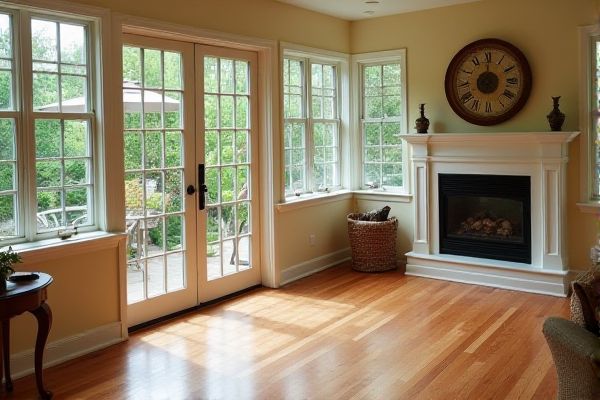
Engineered wood offers superior moisture resistance and stability, making it ideal for sunroom flooring compared to traditional hardwood, which is more susceptible to warping due to temperature fluctuations. Discover the detailed pros and cons of each option to choose the best flooring for your sunroom.
Table of Comparison
| Feature | Engineered Wood Flooring | Hardwood Flooring |
|---|---|---|
| Material Composition | Layered plywood with hardwood veneer | Solid, natural hardwood from a single piece |
| Moisture Resistance | High - suitable for humid sunrooms | Low - prone to warping in moisture |
| Durability | Good - resistant to temperature changes | Excellent - long-lasting if maintained |
| Installation | Float, glue, or nail-down options | Nail-down or glue-down |
| Cost | Moderate - more affordable than hardwood | High - premium pricing |
| Appearance | Authentic wood look with veneer layer | Natural wood grain and texture |
| Maintenance | Lower - resists cracking and cupping | Higher - needs regular sealing and care |
| Eco-Friendliness | Uses less hardwood, more sustainable | Uses solid wood, may have higher environmental impact |
Introduction to Sunroom Flooring Options
Sunroom flooring options primarily include engineered wood and hardwood, each offering distinct durability and aesthetic benefits. Engineered wood features a layered construction that enhances moisture resistance, making it ideal for sunroom environments exposed to fluctuating temperatures and humidity. Hardwood provides timeless beauty and natural warmth but requires careful maintenance to prevent warping or damage in sunroom conditions.
Understanding Engineered Wood Flooring
Engineered wood flooring consists of a plywood base with a hardwood veneer, offering greater stability and resistance to moisture compared to traditional hardwood. This structure makes engineered wood an ideal choice for sunroom flooring, where temperature and humidity fluctuations are common. Its layered construction reduces the risk of warping, ensuring durability and a long-lasting aesthetic in sunroom environments.
What is Hardwood Flooring?
Hardwood flooring consists of solid planks made from natural hardwood trees such as oak, maple, or cherry, offering durability and timeless beauty for your sunroom. Known for its ability to be sanded and refinished multiple times, hardwood provides a long-lasting and elegant surface that enhances the overall value of your home. Engineered wood, while mimicking the look of hardwood, features a layered construction designed to handle moisture variations better, making it an alternative worth considering depending on your sunroom's environmental conditions.
Durability in Sunroom Environments
Engineered wood offers superior durability in sunroom environments due to its multi-layer construction, which provides enhanced resistance to humidity and temperature fluctuations compared to traditional hardwood. Hardwood flooring can be prone to warping and cracking when exposed to prolonged sunlight and moisture common in sunrooms. Choosing engineered wood ensures stable performance and longevity, making it a practical option for sunroom flooring where environmental conditions can be challenging.
Moisture Resistance: Engineered Wood vs Hardwood
Engineered wood flooring offers superior moisture resistance compared to traditional hardwood, as its multi-layer construction with a plywood core minimizes expansion and warping in humid sunroom environments. Hardwood floors, made from solid wood, are more prone to swelling, cupping, and damage when exposed to fluctuating moisture levels typical of sunrooms. Choosing engineered wood ensures enhanced durability and stability, maintaining the floor's integrity despite sunroom humidity variations.
Appearance and Aesthetic Differences
Engineered wood flooring offers a consistent grain pattern and color due to its thin hardwood veneer layer, providing a sleek, uniform sunroom aesthetic. Hardwood flooring showcases natural variations in grain, knots, and color tones, creating a richer, more authentic look that evolves with age and wear. The stability of engineered wood reduces warping in sunroom environments, maintaining its appearance longer than solid hardwood under fluctuating temperature and humidity.
Installation Process and Compatibility
Engineered wood sunroom flooring offers a simpler installation process with click-lock or tongue-and-groove systems that accommodate subfloor variations and humidity changes common in sunrooms. Hardwood flooring requires careful acclimation and professional installation to prevent warping and gaps due to sunroom exposure to sunlight and moisture fluctuations. Engineered wood's layered construction provides better compatibility with radiant heating systems and varying temperature conditions than traditional solid hardwood.
Maintenance and Care Considerations
Engineered wood flooring for sunrooms requires less maintenance due to its stability against humidity and temperature changes, reducing the risk of warping and swelling common in hardwood. Hardwood floors, while durable and aesthetically pleasing, demand regular sealing and humidity control to prevent damage, especially in sun-exposed environments. Both options benefit from routine cleaning with gentle, wood-friendly products and prompt attention to spills to maintain appearance and longevity.
Cost Comparison and Value Over Time
Engineered wood sunroom flooring typically costs less upfront than hardwood, with prices ranging from $4 to $7 per square foot compared to hardwood's $8 to $15 per square foot. Engineered wood offers greater moisture resistance, making it more durable in sunrooms exposed to humidity and temperature changes, which enhances long-term value by reducing maintenance and replacement costs. Your investment in engineered wood balances initial affordability with sustained performance, while hardwood commands a higher price but may require more upkeep to preserve its appearance and structural integrity over time.
Which Flooring Is Best for Your Sunroom?
Engineered wood flooring offers superior moisture resistance and dimensional stability, making it ideal for sunrooms exposed to temperature fluctuations and sunlight. Hardwood flooring provides natural beauty and durability but may expand or contract with humidity changes, requiring more maintenance. For sunrooms, engineered wood delivers a balance of aesthetic appeal and practical performance, ensuring longevity in varying environmental conditions.
 homyna.com
homyna.com